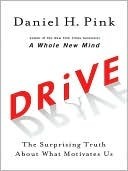More on this book
Community
Kindle Notes & Highlights
Read between
May 9 - July 3, 2021
“When money is used as an external reward for some activity, the subjects lose intrinsic interest for the activity,”
Rewards can deliver a short-term boost—just as a jolt of caffeine can keep you cranking for a few more hours. But the effect wears off—and, worse, can reduce a person’s longer-term motivation to continue the project.
Human beings, Deci said, have an “inherent tendency to seek out novelty and challenges, to extend and exercise their capa...
This highlight has been truncated due to consecutive passage length restrictions.
Dan Ariely, author of Predictably Irrational, a book that offers an entertaining and engaging overview of behavioral economics.
Routine, not-so-interesting jobs require direction; nonroutine, more interesting work depends on self-direction.
The best use of money as a motivator is to pay people enough to take the issue of money off the table.
Over and over again, they discovered that extrinsic rewards—in particular, contingent, expected, “if-then” rewards—snuffed out the third drive.
“When institutions—families, schools, businesses, and athletic teams, for example—focus on the short-term and opt for controlling people’s behavior,” they do considerable long-term damage.3
“People use rewards expecting to gain the benefit of increasing another person’s motivation and behavior, but in so doing, they often incur the unintentional and hidden cost of undermining that person’s intrinsic motivation toward the activity.”4
the solution isn’t algorithmic (following a set path) but heuristic (breaking from the path to discover a novel strategy).
For complex or conceptual tasks, offering a reward can blinker the wide-ranging thinking necessary to come up with an innovative solution.
The problem with making an extrinsic reward the only destination that matters is that some people will choose the quickest route there, even if it means taking the low road.
“Goals may cause systematic problems for organizations due to narrowed focus, unethical behavior, increased risk taking, decreased cooperation, and decreased intrinsic motivation. Use care when applying goals in your organization.”
“as long as the task involved only mechanical skill, bonuses worked as they would be expected: the higher the pay, the better the performance.”
Holding out a prize at the beginning of a project—and offering it as a contingency—will inevitably focus people’s attention on obtaining the reward rather than on attacking the problem.
The more feedback focuses on specifics (“great use of color”)—and the more the praise is about effort and strategy rather than about achieving a particular outcome—the more effective it can be.
In brief, for creative, right-brain, heuristic tasks, you’re on shaky ground offering “if-then” rewards. You’re better off using “now that” rewards. And you’re best off if your “now that” rewards provide praise, feedback, and useful information.
When people aren’t producing, companies typically resort to rewards or punishment. “What you haven’t done is the hard work of diagnosing what the problem is. You’re trying to run over the problem with a carrot or a stick,”
Human beings have an innate inner drive to be autonomous, self-determined, and connected to one another. And when that drive is liberated, people achieve more and live richer lives.
Ultimately, Type I behavior depends on three nutrients: autonomy, mastery, and purpose. Type I behavior is self-directed. It is devoted to becoming better and better at something that matters. And it connects that quest for excellence to a larger purpose.
ROWE—a results-only work environment.
“For me, it’s a partnership between me and the employees. They’re not resources. They’re partners.” And partners, like all of us, need to direct their own lives.
Type I behavior emerges when people have autonomy over the four T’s: their task, their time, their technique, and their team.
an attitude that makes someone less happy as a human being actually makes her more effective as a lawyer.
Most other enterprises are positive-sum. If I sell you something you want and enjoy, we’re both better off. Law, by contrast, is often (though not always) a zero-sum game: Because somebody wins, somebody else must lose.
But the billable hour has little place in Motivation 3.0. For nonroutine tasks, including law, the link between how much time somebody spends and what that somebody produces is irregular and unpredictable.
Ample research has shown that people working in self-organized teams are more satisfied than those working in inherited teams.
studies by Deci and others have shown that people high in intrinsic motivation are better coworkers.
Solving complex problems requires an inquiring mind and the willingness to experiment one’s way to a fresh solution. Where Motivation 2.0 sought compliance, Motivation 3.0 seeks engagement.
In the midst of play, many people enjoyed what Csikszentmihalyi called “autotelic experiences”—from the Greek auto (self) and telos (goal or purpose). In an autotelic experience, the goal is self-fulfilling; the activity is its own reward.
“The desire to do something because you find it deeply satisfying and personally challenging inspires the highest levels of creativity, whether it’s in the arts, sciences, or business.” TERESA AMABILE Professor, Harvard University
a study of 11,000 industrial scientists and engineers working at companies in the United States found that the desire for intellectual challenge—that is, the urge to master something new and engaging—was the best predictor of productivity.
“With a learning goal, students don’t have to feel that they’re already good at something in order to hang in and keep trying. After all, their goal is to learn, not to prove they’re smart.”9
“Purpose provides activation energy for living,” psychologist Mihaly Csikszentmihalyi
In 1962, Clare Boothe Luce, one of the first women to serve in the U.S. Congress, offered some advice to President John F. Kennedy. “A great man,” she told him, “is a sentence.”
before you go to sleep each night, ask yourself the small question: Was I a little better today than yesterday?


